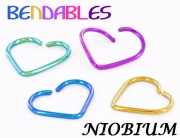Niobium
Jump to navigation
Jump to search
Niobium is an inert elemental metal used to make body jewelry.
Niobium is an elemental metal (Nb, atomic number 41) often used to make colored body jewelry since not only is it totally hypo-allergenic, it can easily be annealed. Niobium jewelry is slightly heavier than stainless steel and is much heavier than titanium. Niobium and titanium are the only two metals used in body modification that can be anodized.
Niobium body jewelry is a Gauntlet innovation. [1]
Interesting side note: Since it doesn't react with uranium and because it is so resistant to corrosion, nuclear reactor cores are made of niobium alloys.
